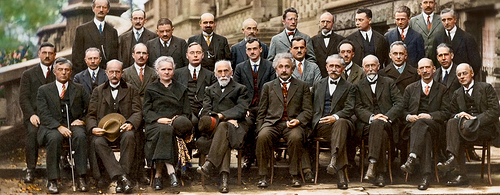No, alas, I don’t have the magical solution to the question here – Why are there still so few women in science?  Just sharing this New York Times article that goes into some depth on a look at this question. When you start with this:
Just sharing this New York Times article that goes into some depth on a look at this question. When you start with this:
“Last summer, researchers at Yale published a study proving that physicists, chemists and biologists are likely to view a young male scientist more favorably than a woman with the same qualifications. Presented with identical summaries of the accomplishments of two imaginary applicants, professors at six major research institutions were significantly more willing to offer the man a job.”
you know you’ve got quite a bit of ground to cover. Or at least, that’s how I viewed the article, and why I read the complete story. Written by a woman who started out studying physics, the article paints a picture of an institution that might not be putting enough effort into encouraging women, no matter how capable, to pursue their interests.
Mostly, though, I didn’t go on in physics because not a single professor — not even the adviser who supervised my senior thesis — encouraged me to go to graduate school. Certain this meant I wasn’t talented enough to succeed in physics, I left the rough draft of my senior thesis outside my adviser’s door and slunk away in shame.
Notice in the above image, there is only one woman in the picture – Marie Curie. Things have certainly improved since 1927, but we as a nation still have far fewer women contributing to the sciences than one might expect. So what is behind this? Is it just a lack of encouragement? Well, no, but that certainly plays into the problem. There’s also the issue of women leaving the workforce when they have children, but even that doesn’t make up the full problem. One additional factor is that women typically get lower salaries, fewer research dollars, less lab space, and poorer equipment.
But broader studies show that the perception of discrimination is often accompanied by a very real difference in the allotment of resources. In February 2012, the American Institute of Physics published a survey of 15,000 male and female physicists across 130 countries. In almost all cultures, the female scientists received less financing, lab space, office support and grants for equipment and travel, even after the researchers controlled for differences other than sex.
And then, let us look at the protrayal of women in science:
Although two of the scientists on the show are women, one, Bernadette, speaks in a voice so shrill it could shatter a test tube. When she was working her way toward a Ph.D. in microbiology, rather than working in a lab, as any real doctoral student would do, she waitressed with Penny. Mayim Bialik, the actress who plays Amy, a neurobiologist who becomes semiromantically involved with the childlike but brilliant physicist Sheldon, really does have a Ph.D. in neuroscience and is in no way the hideously dumpy woman she is presented as on the show.
No, there is not a solution in the article, although the story is well worth reading. And as I already noted, I don’t know the answer. But it is a fascinating question, and one that has led me to look into the issue of women in science more. Watch Little Bits of Science in the near future for articles about famous and not-so-famous female scientists and more discussion on this topic.


 Scientists have done research and determined that
Scientists have done research and determined that  Celebrating 10 years of investigating the Red Planet from above, Wired Magazine presents
Celebrating 10 years of investigating the Red Planet from above, Wired Magazine presents 

